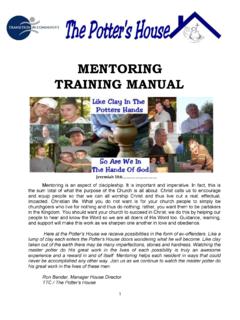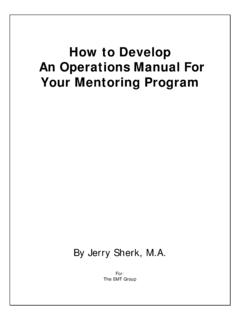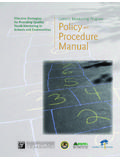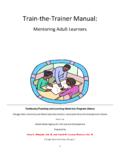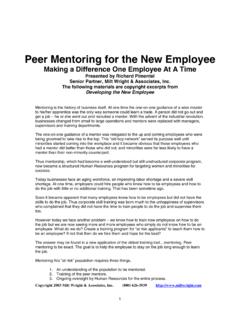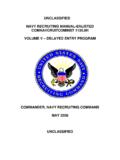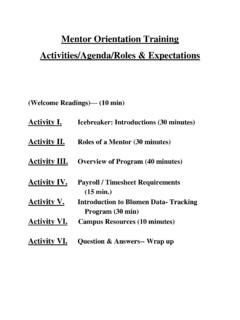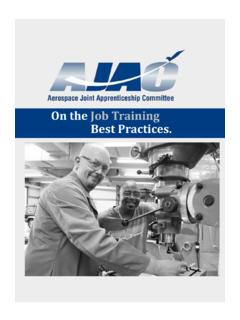Transcription of BY ORDER OF THE SECRETARY AIR FORCE …
1 BY ORDER OF THE SECRETARY AIR FORCE manual 36-2643. OF THE AIR FORCE . 4 MAY 2017. Personnel AIR FORCE mentoring PROGRAM. COMPLIANCE WITH THIS PUBLICATION IS MANDATORY. ACCESSIBILITY: Publications and forms are available for downloading or ordering on at RELEASABILITY: There are no releasability restrictions on this publication OPR: AF/A1D Certified by: SAF/MR. (Mr. Daniel R. Sitterly). Supersedes: AFMAN 36-2643, Pages: 23. 1 May 2013. This publication implements Air FORCE Instruction (AFI) 36-2640, Executing Total FORCE Development. It provides guidance on how to establish a mentoring strategy that is effective for Airmen at any stage in their career. This manual applies to all Airmen-officer, enlisted, civilian, Air National Guard (ANG), and Air FORCE Reserve (AFR).
2 In collaboration with the Chief of Air FORCE Reserve (HQ USAF/RE) and the Director of the Air National Guard (NGB/CF), the Deputy Chief of Staff for Manpower, Personnel, and Services (HQ USAF/A1) develops personnel policy for mentoring . This Air FORCE publication may be supplemented at any level;. Major Command (MAJCOM)-level supplements must be approved by the Human Resource Management Strategic Board (HSB) prior to certification and approval. The authorities to waive wing/unit level requirements in this publication are identified with a Tier ( T-0, T-1, T-2, T-3 ). number following the compliance statement. See AFI 33-360, Publications and Forms Management, for a description of the authorities associated with the Tier numbers. Submit requests for waivers through the chain of command to the appropriate Tier waiver approval authority, or alternately, to the publication Office of Primary Responsibility (OPR) for non-tiered compliance items.
3 AFI 33-332, Air FORCE Privacy Program, sets guidelines for collecting, safeguarding, maintaining, accessing, amending, and disseminating personal data kept in systems of records to comply with the Privacy Program. Refer recommended changes and questions about this publication to the OPR using the AF Form 847, Recommendation for Change of Publication; route the AF Form 847 from the field through the appropriate functional chain of command. Ensure that all records created as a result of processes prescribed in this publication are maintained in accordance with (IAW) Air FORCE manual (AFMAN) 33-363, Management of Records, and disposed of IAW the Air FORCE Records Disposition Schedule (RDS) in the Air FORCE Records Information Management System (AFRIMS). The use of the name or mark of 2 AFMAN36-2643 4 MAY 2017.
4 Any specific manufacturer, commercial product, commodity, or service in this publication does not imply endorsement by the Air FORCE . SUMMARY OF CHANGES. This document has been substantially revised and must be completely reviewed. Major changes include the expansion of information on the mentoring objectives, mentor/mentee guidelines and expectations, and how to build successful mentoring relationships with the addition of trust elements. Definitions for diversity, inclusion, and goal setting are provided. The mentoring Checklist is separated into two separate checklists: one for the mentor and one for the mentee. The mentoring Relationship Types table was modified to include supervisory mentoring and speed mentoring . Revision was made to the mentoring Plan, discussion topics, and resources.
5 1. Responsibilities.. 3. 2. Definition.. 3. 3. Guiding Principles.. 3. 4. Organizational Benefits.. 4. 5. Organizational Goals.. 4. 6. Mentor Guidelines.. 4. 7. Mentor Expectations.. 6. 8. Mentee Guidelines.. 7. 9. Mentee Expectations.. 7. 10. Finding A Mentor.. 7. 11. Successful mentoring Mindset and Relationships.. 8. 12. Preparing A mentoring Plan.. 9. 13. mentoring Discussion Topics .. 9. Attachment 1 GLOSSARY OF REFERENCES AND SUPPORTING INFORMATION 13. Attachment 2 mentoring TOOLKIT 17. AFMAN36-2643 4 MAY 2017 3. 1. Responsibilities. Deputy Chief of Staff for Manpower, Personnel and Services (HQ USAF/A1) is the OPR and establishes mentoring guidance as reflected in this Air FORCE manual . MAJCOMs and local units facilitate the mentoring process to provide Airmen with the ability to develop to their full potential.
6 Air FORCE leaders are expected to ensure Airmen are provided mentoring opportunities as described in this manual . Airmen are expected to follow the process outlined in this manual and become an active partner in their career development and management. 2. Definition. Mentorship is a type of professional relationship in which a person with greater experience and wisdom guides another person to develop both personally and professionally. This relationship helps achieve mission success and motivates Airmen to achieve their goals. mentoring promotes a climate of inclusion that can help foster and develop the diverse strengths, perspectives, and capabilities of all Airmen. Air FORCE capabilities and warfighting competencies are enhanced by diversity among its personnel; reference Air FORCE Policy Directive (AFPD) 36-70, Diversity.
7 mentoring in the Air FORCE is voluntary and uses formal mentoring combined with informal mentoring to professionally develop Airmen based on the needs of the mentee. 3. Guiding Principles. mentoring is an essential ingredient in developing well-rounded, professional, and competent future leaders. The overall goal of mentoring is to help Airmen (civilian, enlisted, and officer) maximize their full potential (reference AFPD 36-26, Total FORCE Development and Management). Mentors should focus on mentee development with a goal of giving the mentee the ability to manage their own development and learning. To effectively mentor Airmen and lift them to a higher level, mentors should have the ability to create positive interactions with mentees. mentoring is meant to be learning focused so that mentees can increase their capacity to accomplish individual and professional goals.
8 The Air FORCE fosters a mentoring culture by encouraging and expecting Airmen to be mentors and mentees. This culture enhances morale and discipline and improves the operational environment while maintaining respect for authority. mentoring is an inherent responsibility of leadership. Key to the mentoring process is the direct involvement of commanders, directors, and supervisors in the professional development of their people (reference AFI 1-2, Commander's Responsibilities). They should continually challenge their Airmen to achieve their individual and/or professional goals. 4 AFMAN36-2643 4 MAY 2017. mentoring promotes professional development at every echelon and activity. mentoring is an ongoing process for building a professional relationship that fosters communication concerning careers, competencies, behavior, and organizational missions.
9 Doctrine Volume II, Leadership; AFI 36-2909, Professional and Unprofessional Relationships; AFI 36-703, Civilian Conduct and Responsibility; Strategic Roadmap: United States Air FORCE Profession of Arms (Profession of Arms Center of Excellence/PACE website); and America's Air FORCE : A Profession of Arms The Little Blue Book, (PACE website) set forth guidelines regarding professionalism. Mentors and mentees should be aware of the Air FORCE definition of diversity, inclusion, and the benefits of a diverse and inclusive approach to leadership and mentorship (reference AFI 36-7001, Diversity). Airmen have the option of selecting or being paired with mentors by using MyVECTOR, Attachment 2, 4. Organizational Benefits. Professional mentoring helps prepare Airmen for increased responsibilities and is not designed to ensure the mentee is selected for a promotion.
10 Some specific benefits are: Improved morale and unit cohesion. Enhanced professional and individual development. Increased mastery of the institutional and occupational competencies (reference AFMAN 36-2647, Institutional Competency Development and Management). Enhanced capacity to translate core values and strategies into productive actions. Greater engagement and retention of Airmen with the right competencies needed in support of Air FORCE requirements. 5. Organizational Goals. Create a positive environment promoting professional and individual growth through the Air FORCE Continuum of Learning (CoL) to enhance institutional and occupational competencies (Doctrine Annex 1-1, FORCE Development). Expand familiarization with the organization's mission through increased understanding of history, heritage, leadership expectations, and the political environment.










